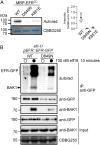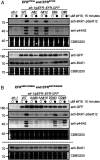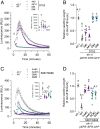Activation loop phosphorylation of a non-RD receptor kinase initiates plant innate immune signaling
- PMID: 34531323
- PMCID: PMC8463890
- DOI: 10.1073/pnas.2108242118
Activation loop phosphorylation of a non-RD receptor kinase initiates plant innate immune signaling
Abstract
Receptor kinases (RKs) are fundamental for extracellular sensing and regulate development and stress responses across kingdoms. In plants, leucine-rich repeat receptor kinases (LRR-RKs) are primarily peptide receptors that regulate responses to myriad internal and external stimuli. Phosphorylation of LRR-RK cytoplasmic domains is among the earliest responses following ligand perception, and reciprocal transphosphorylation between a receptor and its coreceptor is thought to activate the receptor complex. Originally proposed based on characterization of the brassinosteroid receptor, the prevalence of complex activation via reciprocal transphosphorylation across the plant RK family has not been tested. Using the LRR-RK ELONGATION FACTOR TU RECEPTOR (EFR) as a model, we set out to understand the steps critical for activating RK complexes. While the EFR cytoplasmic domain is an active protein kinase in vitro and is phosphorylated in a ligand-dependent manner in vivo, catalytically deficient EFR variants are functional in antibacterial immunity. These results reveal a noncatalytic role for EFR in triggering immune signaling and indicate that reciprocal transphoshorylation is not a ubiquitous requirement for LRR-RK complex activation. Rather, our analysis of EFR along with a detailed survey of the literature suggests a distinction between LRR-RKs with RD- versus non-RD protein kinase domains. Based on newly identified phosphorylation sites that regulate the activation state of the EFR complex in vivo, we propose that LRR-RK complexes containing a non-RD protein kinase may be regulated by phosphorylation-dependent conformational changes of the ligand-binding receptor, which could initiate signaling either allosterically or through driving the dissociation of negative regulators of the complex.
Keywords: phosphorylation; receptor kinase; signaling.
Copyright © 2021 the Author(s). Published by PNAS.
Conflict of interest statement
The authors declare no competing interest.
Figures







Similar articles
-
Allosteric activation of the co-receptor BAK1 by the EFR receptor kinase initiates immune signaling.Elife. 2024 Jul 19;12:RP92110. doi: 10.7554/eLife.92110. Elife. 2024. PMID: 39028038 Free PMC article.
-
Phosphorylation-dependent differential regulation of plant growth, cell death, and innate immunity by the regulatory receptor-like kinase BAK1.PLoS Genet. 2011 Apr;7(4):e1002046. doi: 10.1371/journal.pgen.1002046. Epub 2011 Apr 28. PLoS Genet. 2011. PMID: 21593986 Free PMC article.
-
The phylogenetically-related pattern recognition receptors EFR and XA21 recruit similar immune signaling components in monocots and dicots.PLoS Pathog. 2015 Jan 21;11(1):e1004602. doi: 10.1371/journal.ppat.1004602. eCollection 2015 Jan. PLoS Pathog. 2015. PMID: 25607985 Free PMC article.
-
Plant Leucine-Rich Repeat Receptor Kinase (LRR-RK): Structure, Ligand Perception, and Activation Mechanism.Molecules. 2019 Aug 25;24(17):3081. doi: 10.3390/molecules24173081. Molecules. 2019. PMID: 31450667 Free PMC article. Review.
-
Leucine-rich repeat receptor kinases in plants: structure, function, and signal transduction pathways.Int Rev Cytol. 2004;234:1-46. doi: 10.1016/S0074-7696(04)34001-5. Int Rev Cytol. 2004. PMID: 15066372 Review.
Cited by
-
Reverse engineering of the pattern recognition receptor FLS2 reveals key design principles of broader recognition spectra against evading flg22 epitopes.Nat Plants. 2025 Aug;11(8):1642-1657. doi: 10.1038/s41477-025-02050-5. Epub 2025 Jul 28. Nat Plants. 2025. PMID: 40721668 Free PMC article.
-
The ZmWAKL-ZmWIK-ZmBLK1-ZmRBOH4 module provides quantitative resistance to gray leaf spot in maize.Nat Genet. 2024 Feb;56(2):315-326. doi: 10.1038/s41588-023-01644-z. Epub 2024 Jan 18. Nat Genet. 2024. PMID: 38238629 Free PMC article.
-
Paradigms of receptor kinase signaling in plants.Biochem J. 2023 Jun 28;480(12):835-854. doi: 10.1042/BCJ20220372. Biochem J. 2023. PMID: 37326386 Free PMC article. Review.
-
What's new in protein kinase/phosphatase signalling in the control of plant immunity?Essays Biochem. 2022 Sep 30;66(5):621-634. doi: 10.1042/EBC20210088. Essays Biochem. 2022. PMID: 35723080 Free PMC article. Review.
-
Differential phosphorylation of receptor kinase SlLYK4 mediates immune responses to bacterial and fungal pathogens in tomato.Sci Adv. 2025 May 30;11(22):eadu2840. doi: 10.1126/sciadv.adu2840. Epub 2025 May 30. Sci Adv. 2025. PMID: 40446045 Free PMC article.
References
-
- Hohmann U., Lau K., Hothorn M., The structural basis of ligand perception and signal activation by receptor kinases. Annu. Rev. Plant Biol. 68, 109–137 (2017). - PubMed
-
- Dievart A., Gottin C., Périn C., Ranwez V., Chantret N., Origin and diversity of plant receptor-like kinases. Annu. Rev. Plant Biol. 71, 131–156 (2020). - PubMed
Publication types
MeSH terms
Substances
LinkOut - more resources
Full Text Sources
Molecular Biology Databases
Miscellaneous

